|
|
 |
Fiche d'espèce de Copépode |
|
|
Calanoida ( Ordre ) |
|
|
|
Diaptomoidea ( Superfamille ) |
|
|
|
Candaciidae ( Famille ) |
|
|
|
Candacia ( Genre ) |
|
|
| |
Candacia maxima Vervoort, 1957 (F,M) | |
| | | | | | | Syn.: | ? Candacia sp Mckintosh, 1934 (p.92, fig.F) | | | | Ref.: | | | Vervoort, 1957 (p.142, figs.F,M); Grice, 1963 (p.178); Bradford, 1971 b (p.27, fig.M); Séret, 1979 (p.155, figs.F,M, Rem.); Björnberg & al., 1981 (p.655, figs.F,M, Rem.); Razouls, 1994 (p.178, figs.F,M); Bradford-Grieve, 1999 b (p.171, figs.F,M, Rem., figs.183,193); Park & Ferrari, 2009 (p.143, Table 3, Appendix 1, biogeography from Southern Ocean) |  issued from : Bradford-Grieve J.M. in The Marine Fauna of New Zealand: Pelagic Calanoid Copepoda. National Institute of Water and Atmospheric Research (NIWA). NIWA Biodiversity Memoir, 111, 1999. [p.172, Fig.122]. Female (from 62° S, 170° E): A, urosome (dorsal); B, idem (ventral); C, idem (right side); D, P5 (on one side); E, P5 (idem (on other side). Male (from Ross Sea): F, urosome (dorsal); G, idem (left side); H, segments 14-19 of right A1; I, P5 (L = left leg; R = right leg).
|
 issued from : W. Vervoort in B.A.N.Z. Antarctic Reseach Expedition, Report Ser. B, Vol. III. Copepods. 1957 [Fig.133]. Female (from 47°43'S, 48°E): a, habitus (dorsal); b, posterior part cephalothorax and urosome (dorsal); c, frontal part of cephalothorax (lateral); d, posterior part cephalothorax and urosome (lateral).
|
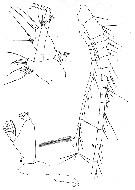 issued from : W. Vervoort in B.A.N.Z. Antarctic Reseach Expedition, Report Ser. B, Vol. III. Copepods. 1957 [Fig.134]. Female: a, Mx1; b-c, right A1; d, left Md.
|
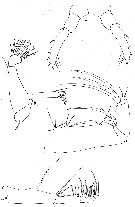 issued from : W. Vervoort in B.A.N.Z. Antarctic Reseach Expedition, Report Ser. B, Vol. III. Copepods. 1957 [Fig.135]. Female: a, P5; b, right A2; c, left Mx2; d, right Mxp.
|
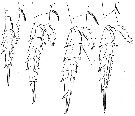 issued from : W. Vervoort in B.A.N.Z. Antarctic Reseach Expedition, Report Ser. B, Vol. III. Copepods. 1957 [Fig.136]. Female: a-d, P1 to P4 (posterior aspects).
|
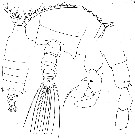 issued from : W. Vervoort in B.A.N.Z. Antarctic Reseach Expedition, Report Ser. B, Vol. III. Copepods. 1957 [Fig.137]. Male: a, habitus (dorsal); b, posterior part cephalothorax and urosome (dorsal); c, P5 (rt = right leg; lt = left leg).
|
 issued from : W. Vervoort in B.A.N.Z. Antarctic Reseach Expedition, Report Ser. B, Vol. III. Copepods. 1957 [Fig.138]. Male: a-b, right A1 (segments 18 and 19 indicated); c, posterior part cephalothorax and urosome (lateral)
|
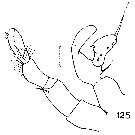 Issued from : J.M. Bradford in N.Z. Oceanogr. Inst., 1971, 206, Part 8, No 59. [p.27, Fig.125]. Male (from 75°09'S, 171°00'W): 125, P5. Scale bar: 100 µm.
|
 Issued from : C. Séret in Thesis 3ème Cycle, UPMC, Paris 6. 1979 [Pl. XLI, Figs.272-275]. Female (from off Kerguelen Is.): 272, habitus (dorsal); 273, last thoracic segùent and urosome (ventral): 274, same (lateral); 275, P5.
|
 Issued from : C. Séret in Thesis 3ème Cycle, UPMC, Paris 6. 1979 [Pl. XLI, Figs.276-279]. Male: 276, habitus (dordal); 277, last thoracic segment and urosome (venyral); 278, same (lateral); 279, P5.
|
 Issued from : C. Séret in Thesis 3ème Cycle, UPMC, Paris 6. 1979 [p.156, Tableau XV]. Body length (L.T) and mean cephalothorax length (L.Cth) in Candacia maxima at three stations from Kerguelen Islands: 5 (50°5, 70°E), 15 (46°S, 64°E) and 12 (56°S, 70°E) in April 1974.
|
 Issued from : C. Razouls in Ann. Inst. océanogr., Paris, 1994, 70 (1). [p.178]. Caractéristiques morphologiques de Candacia maxima femelle et mâle adultes. Terminologie et abbréviations: voir à Calanus propinquus.
| | | | | Ref. compl.: | | | Rudyakov, 1972 (p.886, Table 1: sinking rate); Carter, 1977 (1978) (p.36); Ward, 1989 (tab.2); Errhif & al., 1997 (p.422); Mauchline, 1998 (tab.64); Voronina & Kolosova, 1999 (p.71); Razouls & al., 2000 (p.343, tab. 3, 5, Appendix); Khelifi-Touhami & al., 2007 (p.327, Table 1); Takahashi & al., 2010 (p.317, Table 3, 4); Xavier & al., 2020 (p.20, fig., Rem.). | | | | NZ: | 4 + 1 douteuse | | |
|
Carte de distribution de Candacia maxima par zones géographiques
|
| | | | | | | | | | | | 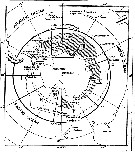 issued from : W. Vervoort in B.A.N.Z. Antarctic Reseach Expedition, Reports - Ser. B, Vol. III, 1957 [Fig.132] issued from : W. Vervoort in B.A.N.Z. Antarctic Reseach Expedition, Reports - Ser. B, Vol. III, 1957 [Fig.132]
Chart showing the geographical distribution (white triangle) in the seas surrounding the Antarctic continent.
Nota: In this chart the area frequented by whaling vessels has been hatched. The Antarctic circle (66°.5 S) has been drawn as a broken line. The numbers I to VI refer to the sectors into which the Antarctic seas are divided according to Mackintosh (1942) (after Vervoort, 1951). |
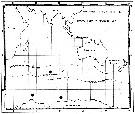 Issued from : C. Séret in Thesis 3ème Cycle, UPMC, Paris 6. 1979, Annexe. [p.51]. Issued from : C. Séret in Thesis 3ème Cycle, UPMC, Paris 6. 1979, Annexe. [p.51].
Geographical occurrences of Candacia maxima in the Indian Ocean and Antarctic zone. [after publications from: Brady, 1883, 1918; Thompson, 1900; Wolfenden, 1908, 1911; With , 1915; Rosendorn, 1917; Farran, 1929; Sewell, 1929, 1947; Brady & Gunther, 1935; Steuer, 1929, 1392, 1933; Ommaney, 1936; Vervoort, 1957; Tanaka, 1960; Brodsky, 1964; Seno, 1966; Andrews, 1966; Grice & Hulsemann, 1967; Seno, 1966; Frost & Fleminger, 1968; Voronina, 1970; Zverva, 1972].
Nota: C. Séret notes the occurrence at stations 49.9°, 75°E; 50.5°, 70°E; 51°S, 65°E; 46°S, 64°E; 56°S, 70°E. |
| | | | Loc: | | | Antarct. (Peninsula, SW Atlant., Scotia Sea, Weddell Sea, Indian, Ross Sea), sub-Antarct. (S Indian (convergence subtropical), Kerguelen Is., SW Atlant., South Africa (Natal), SW Pacif., W Medit. (Gulf of Annaba) | | | | N: | 16 (Antarct., Sub-Antarct.: 12; Indian: 4; ? W Medit.) | | | | Lg.: | | | (25) F: 3,96-3,78; M: 3,87-3,74; (102) M: 3,6; (246) F: 3,99-3,45; M: 3,99-3,46; (909) F: 3,84; {F: 3,45-3,99; M: 3,60-3,99}
The mean female size is 3.804 mm (n = 5; SD = 0.2157), and the mean male size is 3.732 mm (n = 5; SD = 0.2104). The size ratio (male : female) is about 0.98. | | | | Rem.: | mésopélagique.
Sampling depth (Antarct., sub-Antarct.) : 300-600 m.
Pour Vervoort (1957) cette espèce serait préférentiellement sub-antarctique.
Cette espèce probablement subantarctique habiterait dans l'eau intermédiaire entre 250 et 700 m.Elle peut, occasionellement être transportée au sud de la convergence antarctique (Vervoort, 1957). Cette hypothèse de Vervoort est confirmée par les résultats de l'expédition aux Kerguelen (Séret, 1979) puisque c'est la première fois qu'autant d'adultes et de juvéniles sont rapportés autour des Îles Kerguelen et aussi sud que 56°. | | | Dernière mise à jour : 04/02/2021 | |
|
|
 Toute utilisation de ce site pour une publication sera mentionnée avec la référence suivante : Toute utilisation de ce site pour une publication sera mentionnée avec la référence suivante :
Razouls C., Desreumaux N., Kouwenberg J. et de Bovée F., 2005-2025. - Biodiversité des Copépodes planctoniques marins (morphologie, répartition géographique et données biologiques). Sorbonne Université, CNRS. Disponible sur http://copepodes.obs-banyuls.fr [Accédé le 04 décembre 2025] © copyright 2005-2025 Sorbonne Université, CNRS
|
|
 |
 |
















